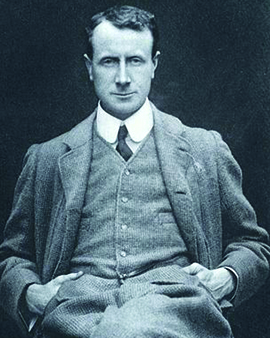Edward Adrian Wilson was the fifth child of the British doctor Edward Thomas Wilson and his wife Mary Agnes. He was an intelligent and sensitive child who was interested in nature and drawing from a very early age and knew at the age of nine what he wanted to be when he grew up - a natural scientist. Later he studied medicine and natural sciences. A very devout Christian, he also spent his free time helping the poor in the slums of Battersea. At the age of 26, Wilson fell seriously ill with tuberculosis and spent several months in Norway and Switzerland to recover. During this time he painted his first landscape paintings. After recovery Wilson married Oriana Souper, who was also a naturalist.
Three weeks after the wedding, Edward Adrian Wilson set out on the Discovery expedition to discover Antarctica. Under the command of the famous polar explorer Captain Robert Falcon Scott, he spent three years in Antarctica as explorer, doctor, chronicler and artist. From this time there are wonderful pictures of him, which depicted the then still unknown region of ice and snow and its unique animal world. During the expedition he made an attempt with Scott and Shackleton to reach the South Pole directly. Due to a serious illness of Shackleton they failed only 500 miles before the finish and had to turn back. Six years later, Wilson, again under Scott's command, went on his second Antarctic expedition. This time they reached the South Pole, five weeks after the Norwegian Roald Amundsen, who won the race to the pole. On the return journey, very bad weather conditions, lack of food and exhaustion caused a catastrophe. All expedition members found death. The bodies of Wilson, Scott and Bowers were later found by a search party and found their graves at their last whereabouts. In 1913 Edward Adrian Wilson was posthumously awarded the highest distinction of the Royal Geographical Society, the "Patron of the Medal", which was given to his widow. On the promenade of Cheltenham, his home town, his statue stands and the municipal museum bears his name. Also certain areas of Antarctica were named after him. His paintings can be found in various museums, the largest collection of his works is in the Scott Polar Research Institute
×





_-_(MeisterDrucke-598265).jpg)
_-_(MeisterDrucke-598265).jpg)
.jpg)
.jpg)
_-_(MeisterDrucke-547349).jpg)
_-_(MeisterDrucke-547349).jpg)
.jpg)
.jpg)
.jpg)
.jpg)
.jpg)
.jpg)
.jpg)
.jpg)
_-_(MeisterDrucke-547350).jpg)
_-_(MeisterDrucke-547350).jpg)
_-_(MeisterDrucke-598253).jpg)
_-_(MeisterDrucke-598253).jpg)
.jpg)
.jpg)
.jpg)
.jpg)
.jpg)
.jpg)
.jpg)
.jpg)
_-_(MeisterDrucke-547443).jpg)
_-_(MeisterDrucke-547443).jpg)
.jpg)
.jpg)
_-_(MeisterDrucke-598284).jpg)
_-_(MeisterDrucke-598284).jpg)
_-_(MeisterDrucke-598287).jpg)
_-_(MeisterDrucke-598287).jpg)
_-_(MeisterDrucke-598281).jpg)
_-_(MeisterDrucke-598281).jpg)
_-_(MeisterDrucke-588364).jpg)
_-_(MeisterDrucke-588364).jpg)
.jpg)
.jpg)
.jpg)
.jpg)
.jpg)
.jpg)
.jpg)
.jpg)
_-_(MeisterDrucke-598276).jpg)
_-_(MeisterDrucke-598276).jpg)
_-_(MeisterDrucke-598274).jpg)
_-_(MeisterDrucke-598274).jpg)
.jpg)
.jpg)
_-_(MeisterDrucke-598277).jpg)
_-_(MeisterDrucke-598277).jpg)
.jpg)
.jpg)
_-_(MeisterDrucke-598282).jpg)
_-_(MeisterDrucke-598282).jpg)
_-_(MeisterDrucke-598256).jpg)
_-_(MeisterDrucke-598256).jpg)
_-_(MeisterDrucke-563541).jpg)
_-_(MeisterDrucke-563541).jpg)
.jpg)
.jpg)
.jpg)
.jpg)
.jpg)
.jpg)
.jpg)
.jpg)
_(see_also_4385)_-_(MeisterDrucke-588365).jpg)
_(see_also_4385)_-_(MeisterDrucke-588365).jpg)
_-_(MeisterDrucke-598263).jpg)
_-_(MeisterDrucke-598263).jpg)
.jpg)
.jpg)
.jpg)
.jpg)
_-_(MeisterDrucke-598254).jpg)
_-_(MeisterDrucke-598254).jpg)
.jpg)
.jpg)
_-_(MeisterDrucke-598258).jpg)
_-_(MeisterDrucke-598258).jpg)
_-_(MeisterDrucke-598257).jpg)
_-_(MeisterDrucke-598257).jpg)
_-_(MeisterDrucke-598252).jpg)
_-_(MeisterDrucke-598252).jpg)
_-_(MeisterDrucke-598268).jpg)
_-_(MeisterDrucke-598268).jpg)
_-_(MeisterDrucke-598266).jpg)
_-_(MeisterDrucke-598266).jpg)
_-_(MeisterDrucke-598280).jpg)
_-_(MeisterDrucke-598280).jpg)
.jpg)
.jpg)
.jpg)
.jpg)
_-_(MeisterDrucke-547444).jpg)
_-_(MeisterDrucke-547444).jpg)
.jpg)
.jpg)
_-_(MeisterDrucke-598262).jpg)
_-_(MeisterDrucke-598262).jpg)
_-_(MeisterDrucke-598259).jpg)
_-_(MeisterDrucke-598259).jpg)
.jpg)
.jpg)
_-_(MeisterDrucke-598275).jpg)
_-_(MeisterDrucke-598275).jpg)
_-_(MeisterDrucke-598261).jpg)
_-_(MeisterDrucke-598261).jpg)
.jpg)
.jpg)
_-_(MeisterDrucke-1103158).jpg)
_-_(MeisterDrucke-1103158).jpg)
_-_(MeisterDrucke-598283).jpg)
_-_(MeisterDrucke-598283).jpg)
.jpg)
.jpg)
.jpg)
.jpg)
_-_(MeisterDrucke-598267).jpg)
_-_(MeisterDrucke-598267).jpg)






